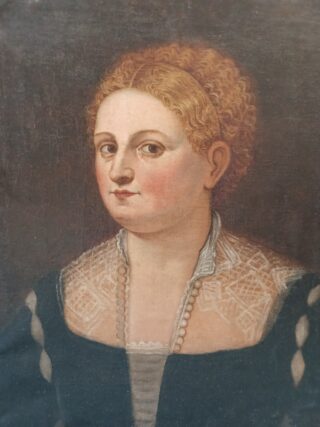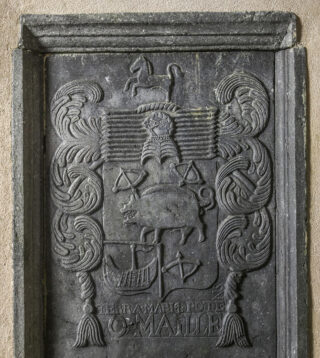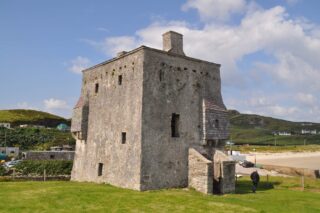
There are many names The Pirate Queen is known by today, but she is probably best known as Gráinne O’Máille (Grace O’Malley) or Granuaile. Three castles in Mayo are referred to by her name: Rockfleet Castle, Kildavnet Castle, and Clare Island Castle are also known as Granuaile’s Castles/Towers. Both Kildavnet and Clare Island Castle were built, in the 15th and 16th centuries, by the O’Malley family, a powerful Gaelic clan within Connaught. Rockfleet, a 15th/16th century tower, was owned by the Burke family, descendants of the Anglo-Norman de Burgos. It was this castle that became Gráinne’s base of piracy operations through her marriage to her second husband, Richard-an- Iarainn Burke.
Gráinne spent her childhood between the family castles of Belclare in Co. Galway, and Clare Island in Co. Mayo. It is likely that her education was delivered by the monks who lived in the abbey on Clare Island, an abbey of which the O’Malley’s were patrons. The original abbey is said to date back to the 13th century, while the church that exists on the island today dates to around the 15th century and contains the tomb of the O’Malley family. A plaque with the family motto ‘Terra Mariq Potens’ (Powerful by Land and Sea), sits beside a canopied tomb, believed to be the burial place of Gráinne O’Máille herself. Today, the church contains some of the finest medieval frescoes in Ireland.

Gráinne returned home to Clare Island after the murder of her first husband, Dónal O’Flaherty, by a rival clan in 1565. It was then that she established her fleet of three galleys and an army of 200 men. This army was partially made up of O’Flaherty men, who followed her leadership after her husband’s death. Such loyalty was a testament to her prowess as a leader, as well as her tenacity; something which was displayed from a young age. Wanting to join her father on a voyage to Spain, Gráinne cut her hair like a boy, earning her the nickname Gráinne Mhaol (Grace the Bald).
The castle on Clare Island was situated near the harbour, making it the perfect place for Gráinne to begin her career as a ‘sea merchant’. The castle is three storeys tall, with the main living room likely situated on the first floor, and there is evidence that gun-loops existed which are now blocked up. A parapet walk is situated along the top of the north and south walls, a typical security feature of castles from the medieval period.

Gráinne was strategic in where she operated her fleets from, and her second marriage to Richard-an-Iarainn Burke was one driven by material convenience. She wanted access to his castle at Rockfleet, ideally located on a quiet inlet of Clew Bay, not too far from the O’Malley Kildavnet Castle overlooking the Achill Sound. Both castles are four storeys high, with stunning views over the surrounding water and land, perfect for observing oncoming attacks. It was known that Gráinne launched attacks on trading ships from Galway during her time at Rockfleet, leading to an attempted siege of the castle in 1579 by Captain William Martin.
The Captain very nearly became Gráinne’s captive.
Gráinne and Richard agreed to a trial marriage of a year, with folklore claiming that after the year was up Gráinne locked Richard out of Rockfleet Castle and demanded a divorce. This is unlikely given that the couple were married right up to his death in 1584.

It was after Richard’s death that life became increasingly difficult for Gráinne in the form of newly appointed Governor of Connaught, Richard Bingham; whose sights became set on the fearsome queen of the sea. After enduring imprisonment in Dublin Castle, the capture of her youngest son, and the confiscation and destruction of her fleet and lands over a number of years, Gráinne took a stand and appealed directly to Queen Elizabeth I to end Bingham’s vendetta. They met in 1593, with the Queen granting Gráinne’s return to the sea and rebuilding of her fleet, believing the Pirate Queen would be fighting the Queen’s cause on the waters. Gráinne now had a fleet of three galleys
capable of carrying 300 men each.
It is said that Gráinne O’Máille died in 1603 at Rockfleet Castle, and now rests on Clare Island. Her strength and her fierce nature did not go unnoticed by the men she dealt with throughout her life. Sir Henry Sidney (English Lord Deputy) stated that she was the most ‘notorious woman in all the coasts of Ireland’, while Sir Nicholas Malby (Governor of Connaught) claimed ‘she thinketh herself to be no small lady’. Gráinne lived an adventurous and vivid life, and her monuments in County Mayo reflect the larger than life character of this extraordinary woman.
More information on these unguided monuments in Mayo can be found here
Sources:
- Chambers, Anne. Ireland’s Pirate Queen: the true story of Grace O’Malley, 2003.
- Dib.ie/biography – contributed by Emmet O’Byrne
- Harbison, Peter. Guide to National and Historic Monuments of Ireland, 1992.
- maps.arcgis.com – Historic Environment Viewer
- Tuatha.ie


